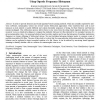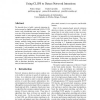58 search results - page 5 / 12 » Detection of New Malicious Code Using N-grams Signatures |
SP
2008
IEEE
15 years 5 months ago
2008
IEEE
Rootkits are used by malicious attackers who desire to run software on a compromised machine without being detected. They have become stealthier over the years as a consequence of...
115
click to vote
CORR
2011
Springer
14 years 5 months ago
2011
Springer
Abstract- In order to prevent detection and evade signature-based scanning methods, which are normally exploited by antivirus softwares, metamorphic viruses use several various obf...
MATA
2004
Springer
15 years 4 months ago
2004
Springer
Mobile agents are software entities consisting of code, data and state that can migrate autonomously from host to host executing their code. Unfortunately, security issues restrict...
EPIA
2003
Springer
15 years 4 months ago
2003
Springer
We describe how to build a network intrusion detection sensor by slightly modifying NASA’s CLIPS source code introducing some new features. An overview of the system is presente...
103
click to vote
ACSAC
2010
IEEE
14 years 7 months ago
2010
IEEE
Heap spraying is an attack technique commonly used in hijacking browsers to download and execute malicious code. In this attack, attackers first fill a large portion of the victim...


